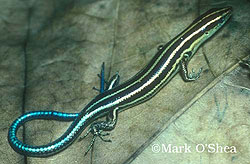A look at the blue-tailed skink.
Distribution: Eastern Indonesia, New Guinea, Solomon Islands, Micronesia, Vanuatu and Fiji.
Habitat: Coconut plantations, gardens and forest edges.
Diet: Insects.
Max. length: 50mm SVL (115mm TL).
Reproductive strategy: Oviparous with clutches of 2 eggs.
The combination of electric blue tail with black body and three longitudinal yellow body stripes in a common pattern found in skinks, lacertids and other lizards around the world. It is possible that the stripes are intended to direct the eye of the predator towards the bright tail, thereby deflecting an attack away from the vulnerable lizard body. In New Guinea the blue-tailed skink exhibits sexual dichromatism, the females are brightly marked with blue tails while male blue-tailed skinks are usually light brown with indistinct stripes and a brown tail. These highly visible diurnal skinks are commonly observed on low vegetation and low on tree trunks, flicking their long tails.

Photo Credit: Mark O'Shea
Sources for more information:
Brown W.C. 1991 Lizards of the genus Emoia (Scincidae) with observations on their evolution and biogeography. Mem. Calif. Acad. Sci. 15 vi+94.
McCoy M. 1980 Reptiles of the Solomon Islands. Wau Ecology Handbook No.7. vi+80.
Mys B. 1988 The zoogeography of the scincid lizards from North Papua New Guinea (Reptilia: Scincidae). I. The distribution of the species. Bulletin de L'Institute Royal des Sciences Naturelles de Belgique. 58;127-183.


